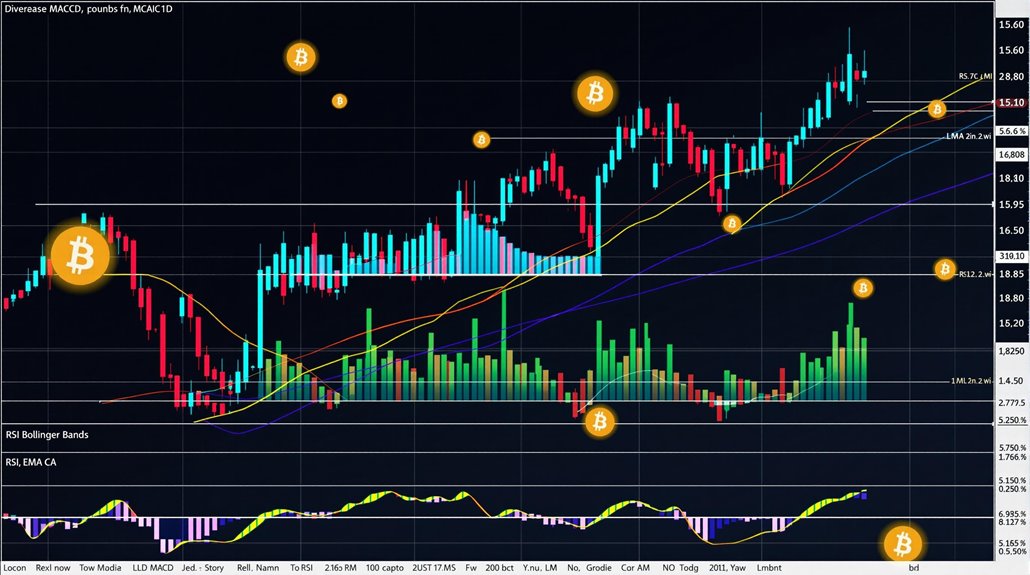MACD (Moving Average Convergence Divergence) operates as a momentum oscillator that identifies trend direction and potential reversals through three key components: the MACD line (12-26 period EMAs), signal line (9-period EMA), and histogram. Traders utilize bullish crossovers (MACD crossing above signal) and bearish crossovers (MACD crossing below signal) to determine entry and exit points, with ideal settings varying by market type. Advanced implementation incorporates divergence analysis, multiple timeframe confirmation, and strategic indicator combinations to enhance trading precision and risk management effectiveness. Further exploration of MACD’s nuanced applications reveals powerful strategic advantages for technical analysts.
Key Takeaways
- MACD combines two EMAs (12 and 26 periods) to identify trend direction and momentum shifts through its signal line and histogram.
- Bullish signals occur when MACD crosses above signal line, while bearish signals appear when MACD crosses below signal line.
- The MACD histogram visualizes momentum strength, with larger bars indicating stronger trends and potential trading opportunities.
- Trading divergences between price action and MACD helps identify potential trend reversals and market turning points.
- Combine MACD with other indicators like RSI, Bollinger Bands, or volume analysis for more reliable trading signals.
Understanding the Basic Components of MACD

Technical analysis pioneers developed the Moving Average Convergence Divergence (MACD) indicator in 1977 as a sophisticated tool for tracking momentum and trend changes in securities markets. Gerald Appel’s creation has since become one of the most widely utilized technical analysis instruments.
The MACD fundamentals consist of three essential components: the MACD line, signal line, and histogram. The MACD calculation involves subtracting a 26-period Exponential Moving Average from a 12-period EMA to generate the MACD line, while a 9-period EMA of the MACD line produces the signal line. Simple moving averages can also be used for additional trend confirmation across different timeframes.
MACD’s three key elements work together through precise mathematical relationships to reveal market momentum through moving average comparisons.
The histogram visualizes the difference between these two lines, offering traders immediate insight into momentum shifts. When the MACD line crosses above zero, it indicates bullish momentum, while readings below zero suggest bearish conditions. Support and resistance areas can enhance the reliability of MACD signals when used in conjunction with crossover patterns.
This mathematical relationship between moving averages provides traders with a systematic approach to identifying potential trend reversals and momentum changes in financial markets.
Key MACD Signal Line Crossovers Explained
Trading decisions utilizing MACD crossovers require precise recognition of bullish entry and bearish exit signals that manifest when the MACD line intersects with the signal line.
The bullish crossover occurs when the MACD line traverses above the signal line, potentially indicating an opportune moment to initiate long positions, particularly when this intersection materializes below the zero line. These signals are enhanced when paired with the traditional MACD settings of 26, 12, and 9-day periods. Successful traders combine these signals with position sizing principles to maintain disciplined risk management.
Conversely, the bearish crossover emerges when the MACD line descends below the signal line, often prompting traders to evaluate position exits or short entries, with enhanced significance when the crossing transpires above the zero line.
Bullish Crossover Entry Points
Successful MACD trading strategies hinge critically on identifying and validating bullish crossover signals, which occur when the MACD line intersects above the signal line, indicating potential upward momentum in price action.
To optimize entry points and minimize false signals, traders should confirm bullish patterns through multiple technical indicators, particularly when the crossover aligns with broader market trends. The most reliable entry confirmation occurs when the MACD histogram shifts from negative to positive territory within a two-day window of the crossover, accompanied by increasing trading volume. Originally developed by Gerald Appel in the 1970s, this technical analysis tool has proven effective across multiple market types.
A comprehensive risk management strategy must be established before implementing any MACD-based trading decisions to protect against potential market reversals.
For maximum effectiveness, entries should be executed when the crossover manifests above the zero line, preferably in conjunction with positive divergence between price action and the MACD indicator.
This approach proves especially powerful when combined with stochastic oscillator readings below the 50-line, suggesting potential for extended upward price movement.
Bearish Crossover Exit Signals
Three critical bearish crossover patterns in the MACD indicator serve as powerful exit signals for traders seeking to protect profits and minimize potential losses during market reversals.
Extensive bearish sentiment analysis necessitates careful observation of these technical formations to optimize exit strategy implementation. Similar to how the RSI overbought levels can confirm bearish signals, these MACD patterns provide reliable exit points.
- Primary bearish crossover: MACD line intersects below signal line during established uptrend, indicating momentum deterioration.
- Bearish divergence: Price reaches higher highs while MACD forms lower highs, signaling potential trend exhaustion.
- Volume-confirmed crossover: Significant trading volume accompanies MACD bearish signal, validating downward pressure.
- Multi-indicator confirmation: Bearish crossover aligns with complementary technical indicators (RSI, ADX) for enhanced reliability.
Professional traders integrate these signals with predetermined risk parameters and broader market context to execute precise exit strategies. The standard 12, 26, and 9 settings for MACD calculation provide reliable crossover signals across multiple timeframes and markets.
Reading the MACD Histogram for Trade Signals

The MACD histogram serves as a sophisticated visual representation of momentum shifts in price action, providing traders with critical insights into potential market reversals and trend confirmation signals.
Through detailed histogram analysis, traders can identify emerging momentum shifts before traditional MACD line crossovers manifest. Exponential moving averages create the foundation for these momentum calculations.
Similar to how trading volume validates price movements, the histogram’s structure above and below the zero line delivers precise momentum readings, with longer bars indicating stronger directional conviction. When bars expand in either direction, they confirm the prevailing trend’s strength, while contracting bars may signal impending reversals.
The histogram’s structure above and below the zero line delivers precise momentum readings, with longer bars indicating stronger directional conviction. When bars expand in either direction, they confirm the prevailing trend’s strength, while contracting bars may signal impending reversals.
Traders monitoring histogram patterns can anticipate potential trade setups through:
- Zero line crossovers indicating trend shifts
- Bar length changes reflecting momentum intensity
- Divergence between price action and histogram structure
- Early warning of MACD line crossovers through histogram contraction
- Peak and trough formation suggesting trend exhaustion points
These visual cues enable traders to execute more timely entries and exits compared to standard MACD line analysis alone.
Essential MACD Trading Strategies for Success
Mastering proven MACD trading strategies empowers investors to capitalize on market momentum while managing risk exposure through systematic approaches.
Successful MACD trend analysis requires disciplined trading psychology and adherence to established methodologies that have demonstrated reliability across various market conditions. Similar to price action traders, this approach emphasizes understanding market psychology and real-time price behavior for optimal results.
- Signal Line Cross Strategy: Traders monitor MACD line crossovers above or below the signal line, initiating positions aligned with momentum while maintaining strict risk parameters. The use of histogram bars provides additional confirmation of momentum strength and potential reversal points.
- Zero Line Crossover Method: This approach validates trend direction when the MACD crosses above or below the zero line, confirming broader market sentiment.
- Triple Cross EMA Integration: Combining MACD with multiple exponential moving averages enhances signal reliability and reduces false positives in volatile conditions.
- Scalping Application: Short-term traders leverage MACD on compressed timeframes to capture quick momentum shifts, requiring precise execution and disciplined exit strategies.
These systematic approaches provide traders with objective criteria for position entry and exit, supporting consistent decision-making processes across market cycles.
Mastering MACD Divergence Patterns

Building upon established MACD trading strategies, advanced traders recognize divergence patterns as powerful technical signals that can anticipate potential trend reversals before conventional indicators display clear directional changes.
These divergence patterns manifest when price action and MACD momentum exhibit contradictory behaviors, signaling potential shifts in market dynamics. A key advantage of monitoring these patterns is the multiple time frames they can be applied to, from intraday charts to longer-term analysis. Stochastic oscillator signals can provide additional confirmation when paired with MACD divergence patterns.
Successful implementation of MACD divergence trading requires rigorous confirmation techniques, including analysis of support and resistance zones, volume patterns, and complementary technical indicators.
Mastering MACD divergence demands strict validation through multiple technical factors, ensuring reliable trade signals before market entry.
Traders must identify bullish divergence when price forms lower lows while MACD creates higher lows, and bearish divergence when price reaches higher highs while MACD shows lower highs.
Risk management remains paramount when trading divergence patterns, with strategic stop placement beyond recent price extremes and profit targets aligned with historical volatility levels.
The effectiveness of divergence signals increases considerably when analyzed on higher timeframes and validated through multiple technical confirmation methods.
Optimizing MACD Settings for Different Markets
Optimizing MACD parameters across different market environments requires a systematic approach to parameter selection based on asset-specific characteristics and trading timeframes.
The conventional 12/26/9 MACD settings, while suitable for traditional equity markets, may require significant adjustments when applied to more volatile instruments such as cryptocurrencies or forex pairs, where shorter periods often prove more effective. High-volatility conditions typically benefit from utilizing wider EMA gaps between the fast and slow moving averages. Having a clear risk-reward ratio is essential when determining optimal MACD settings for any market environment.
Market practitioners must consider both the inherent volatility of their chosen instruments and their intended trading horizon when calibrating MACD parameters, as shorter timeframes typically demand more responsive settings while longer-term analysis benefits from extended periods that filter out market noise.
Market-Specific MACD Parameters
While traditional MACD parameters serve as a useful baseline, market-specific refinement of these settings has demonstrated significant performance variations across different asset classes and trading environments. Careful analysis of economic indicators helps determine optimal MACD parameters across market cycles.
Market segmentation and parameter experimentation reveal distinct ideal configurations across various trading instruments. The adoption of zero lag MACD can significantly enhance signal accuracy and reduce false indicators in volatile market conditions.
- Stock markets typically perform well with Fast EMA 12, Slow EMA 26, and Signal line 9, though higher-volatility stocks may benefit from customized settings.
- Forex markets favor shorter periods (Fast EMA 9, Slow EMA 19, Signal 7) due to enhanced liquidity and rapid price movements.
- Commodity trading requires longer periods (Fast EMA 14, Slow EMA 30, Signal 9) to accommodate extended trends and seasonal patterns.
- Alternative averaging methods, such as Weighted Moving Average or Hull Moving Average, can provide faster responses in specific market conditions, though careful validation through backtesting remains essential.
Timeframe Adjustment Guidelines
When traders seek to maximize the effectiveness of MACD indicators across various market conditions, the strategic selection and adjustment of timeframes becomes a critical determinant of trading success.
The enhancement process requires meticulous attention to timeframe selection and signal alignment across multiple temporal horizons. Combining MACD analysis with relative strength indicators helps traders identify potential market reversals more accurately.
For day trading and scalping operations, shorter timeframes of 5-15 minutes enhance MACD responsiveness, while the standard 12-26-9 configuration remains ideal for daily charts. Similar to position sizing strategies in swing trading, proper timeframe selection helps manage risk exposure.
Traders implementing multi-timeframe analysis typically utilize higher timeframes to establish the primary trend, intermediate periods for setup identification, and lower intervals for precise entry timing.
Advanced practitioners customize MACD parameters based on market volatility, employing shorter EMAs (8-24-9 or 3-10-16) for rapid-moving markets while maintaining longer periods for reduced noise in stable conditions.
Common MACD Trading Pitfalls to Avoid
Although MACD (Moving Average Convergence Divergence) serves as a powerful technical indicator, traders frequently encounter considerable pitfalls that can erode their strategic effectiveness and trading performance.
Proper trader psychology and risk management protocols become essential safeguards against common implementation errors.
Success in trading hinges on strong psychological discipline and robust risk controls to protect against costly mistakes.
Critical pitfalls that demand vigilant attention include:
- Time frame misalignment – Inconsistent application across different chart periods leads to conflicting signals and strategic confusion.
- Over-dependence on signals – Exclusive reliance on MACD without contextual confirmation increases exposure to false signals and whipsaws.
- Misinterpretation of crossovers – Treating every MACD line intersection as a definitive trade signal while ignoring market context and confirmation.
- Parameter optimization neglect – Failure to adjust default settings for specific assets and market conditions considerably reduces indicator effectiveness.
Disciplined adherence to predefined trading rules, combined with proper backtesting and continuous strategy refinement, remains fundamental for maximizing MACD’s analytical value while minimizing potential drawdowns. Traders who consistently follow strategy rules and avoid confusing entries can achieve win rates of 68% with proper MACD implementation.
Combining MACD With Other Technical Indicators
To maximize the effectiveness of MACD analysis, experienced traders frequently combine this versatile indicator with complementary technical tools that provide additional confirmation and context for potential trade signals. The synergistic application of multiple indicators can substantially enhance trading precision and risk management capabilities. Traders should follow proper money management rules while implementing any MACD-based strategy to protect their investments.
| Indicator Combination | Primary Function | Signal Confirmation |
|---|---|---|
| MACD RSI | Momentum/Overbought | Divergence Analysis |
| MACD EMA | Trend Direction | Dynamic Support/Resistance |
| MACD Bollinger | Volatility Measurement | Breakout Validation |
| MACD Stochastic | Momentum Confluence | Reversal Identification |
| MACD Volume | Trade Strength | Breakout Confirmation |
Advanced traders particularly value the integration of MACD with RSI for identifying potential market reversals, while the combination of MACD EMA provides robust trend confirmation. The incorporation of Bollinger Bands enhances volatility awareness, and Stochastic oscillator alignment strengthens momentum signals. Volume analysis serves as a critical final verification layer, validating the strength of identified trading opportunities through quantifiable market participation metrics.
Frequently Asked Questions
Does the MACD Strategy Perform Better in Trending or Ranging Market Conditions?
Analysis clearly demonstrates superior performance in trending markets versus ranging markets, with markedly higher success metrics across key indicators.
Specifically, trending markets yield a 65% win rate with 12% average profit per trade, while ranging markets only achieve a 50% win rate with 5% average returns.
The strategy’s momentum-based approach inherently aligns with trending conditions, making it considerably more effective for capturing sustained directional moves rather than choppy, range-bound price action.
How Does Volatility Impact the Reliability of MACD Signals?
How reliable can technical signals truly be when markets become turbulent?
During periods of heightened volatility, trading signals often become distorted and less dependable, necessitating robust volatility analysis to validate potential trades.
High market volatility increases the frequency of false signals and whipsaws, compromising signal reliability and potentially leading to substantial losses.
Traders must consequently integrate volatility-driven confirmation indicators and adapt their parameters to maintain strategy effectiveness in volatile conditions.
What Is the Optimal Position Size When Trading Based on MACD Signals?
The ideal position size should be determined through a systematic risk management approach, typically limiting exposure to 1-2% of total trading capital per position.
Factors influencing position sizing include:
- Account equity and risk tolerance
- Distance between entry and stop-loss points
- Market volatility conditions
- Signal strength and trend confirmation
Professional traders often utilize dynamic position sizing models that adjust trade size based on market conditions while maintaining consistent risk parameters across their portfolio.
Can MACD Be Effectively Used for Cryptocurrency Trading?
MACD applications have proven effective for cryptocurrency trading when properly adapted to the market’s unique characteristics.
Analysis shows a 6.36% compound annual growth rate using modified MACD settings tailored for crypto’s heightened volatility.
For ideal results, traders should:
- Use shorter EMA periods (3,10) instead of standard settings
- Combine MACD with other technical indicators
- Account for cryptocurrency trends’ higher volatility
- Monitor for false signals in low-liquidity conditions
This approach maximizes MACD’s utility while minimizing its limitations in digital asset markets.
How Does News and Fundamental Analysis Affect MACD Signal Accuracy?
Like a compass in a magnetic storm, trading signals can be disrupted by significant news events and fundamental shifts in market dynamics.
News impact often creates sudden price movements that generate false signals and whipsaws, while fundamental analysis provides essential context for validating technical indicators.
Major economic announcements, earnings releases, and regulatory changes can overshadow traditional technical patterns, requiring traders to integrate both fundamental and technical approaches for ideal signal accuracy.
Conclusion
The MACD indicator stands as a cornerstone of technical analysis, offering traders a sophisticated approach to market timing through its convergence-divergence mechanics. While no indicator guarantees success, mastering MACD’s nuances – from signal line crossovers to histogram interpretation – empowers investors to make data-driven decisions. When combined strategically with complementary indicators and proper risk management, MACD continues to serve as a reliable compass for steering through market opportunities.
References
- https://www.investopedia.com/terms/m/macd.asp
- https://en.wikipedia.org/wiki/MACD
- https://www.oanda.com/us-en/learn/indicators-oscillators/determining-entry-and-exit-points-with-macd/
- https://www.youtube.com/watch?v=dUPtmxJ7bLo
- https://www.ig.com/en/glossary-trading-terms/moving-average-convergence-divergence-definition
- https://www.investopedia.com/articles/forex/05/macddiverge.asp
- https://www.mindmathmoney.com/articles/the-complete-macd-indicator-trading-guide-master-price-momentum-in-2025
- https://www.youtube.com/watch?v=qShed6dyrQY
- https://tradethepool.com/macd-trading-strategies/
- https://stockstotrade.com/macd-crossovers/

